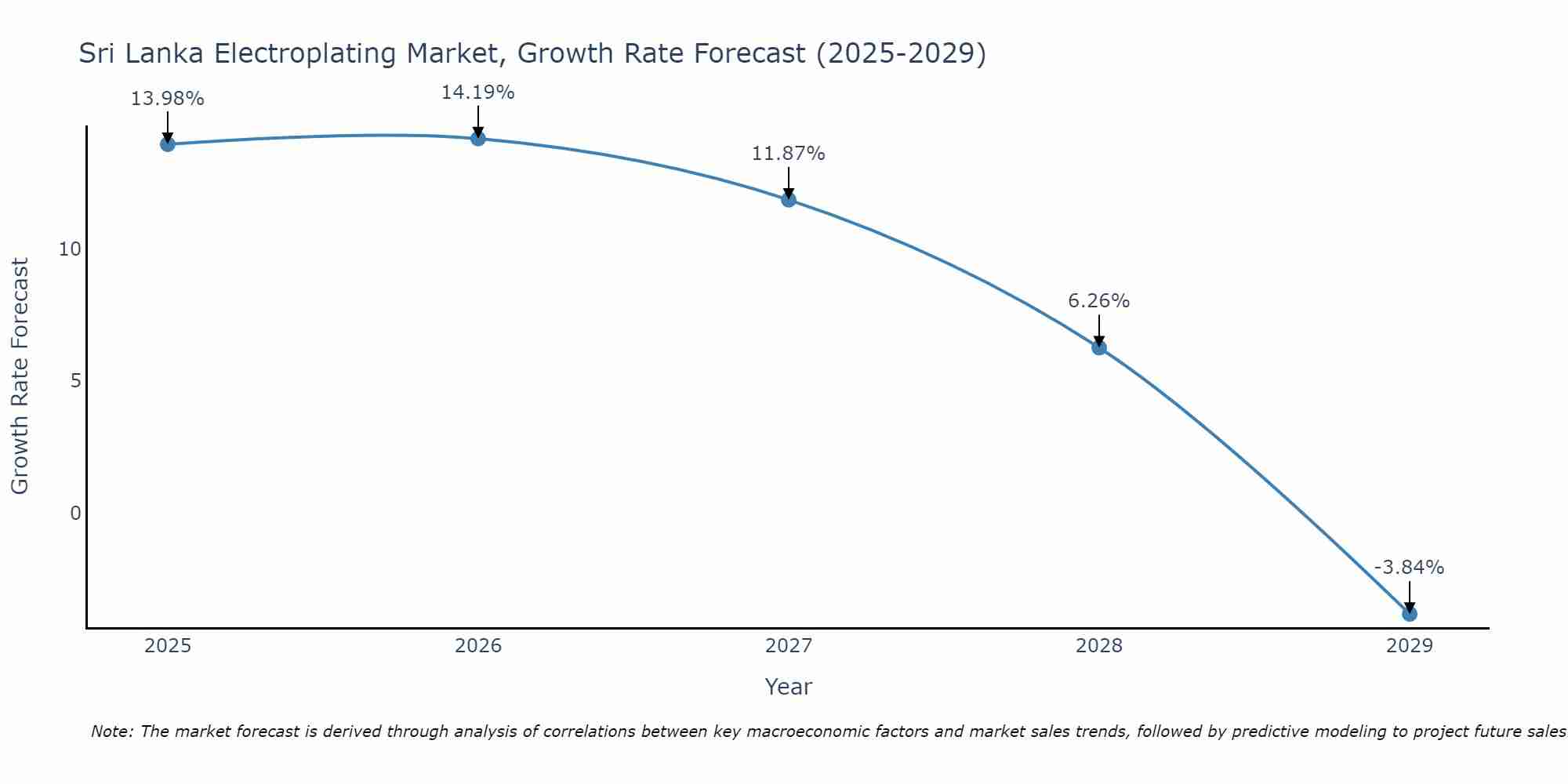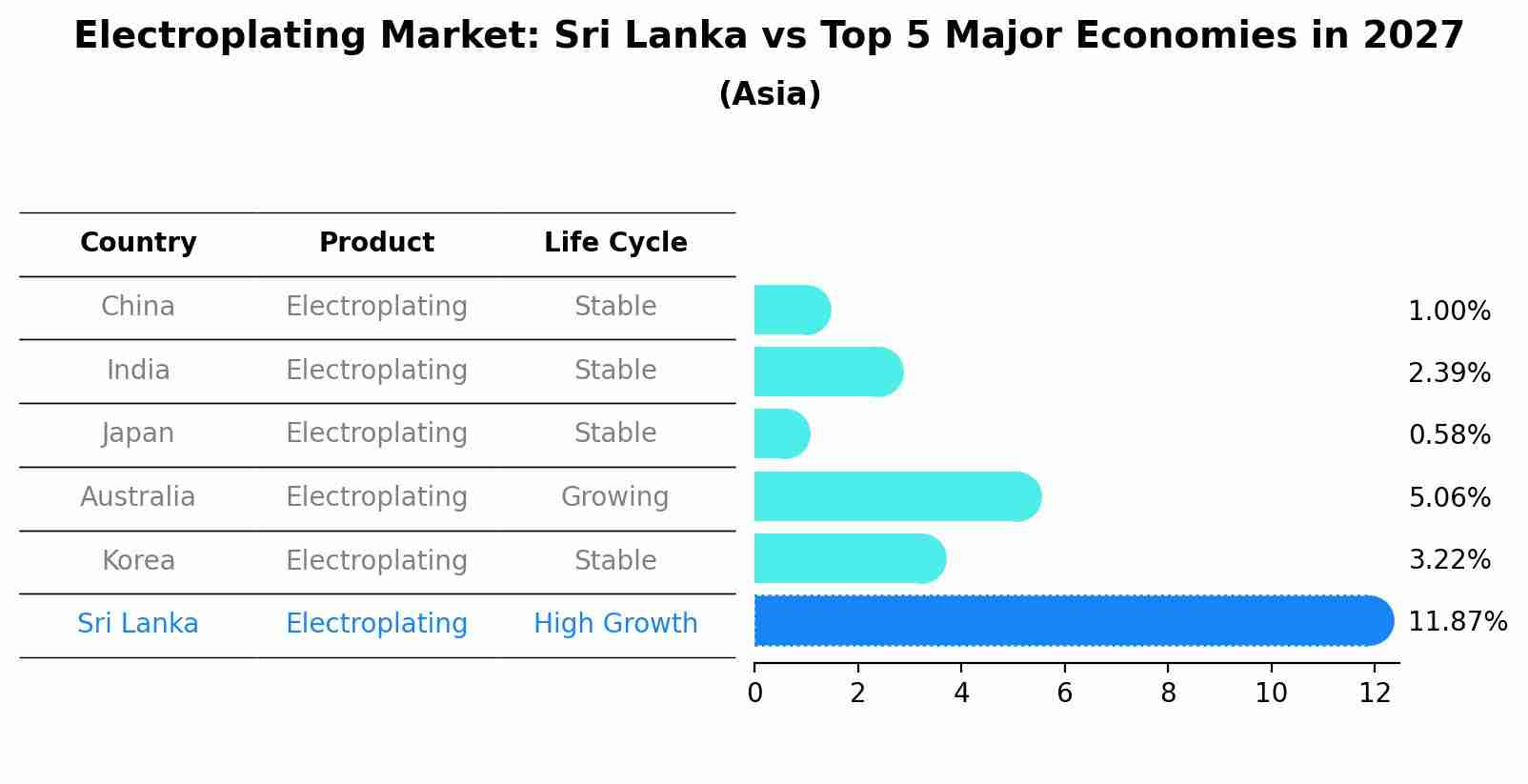Sri Lanka Electroplating Market Outlook | Analysis, Industry, Size, Forecast, Value, Share, Companies, COVID-19 IMPACT, Revenue, Trends & Growth
| Product Code: ETC104630 | Publication Date: Jun 2021 | Updated Date: Jun 2025 | Product Type: Report | |
| Publisher: 6Wresearch | Author: Ravi Bhandari | No. of Pages: 70 | No. of Figures: 35 | No. of Tables: 5 |
Sri Lanka Electroplating Market Size Growth Rate
The Sri Lanka Electroplating Market is projected to witness mixed growth rate patterns during 2025 to 2029. The growth rate begins at 13.98% in 2025, climbs to a high of 14.19% in 2026, and moderates to -3.84% by 2029.

Electroplating Market: Sri Lanka vs Top 5 Major Economies in 2027 (Asia)
The Electroplating market in Sri Lanka is projected to grow at a high growth rate of 11.87% by 2027, highlighting the country's increasing focus on advanced technologies within the Asia region, where China holds the dominant position, followed closely by India, Japan, Australia and South Korea, shaping overall regional demand.

Sri Lanka Electroplating Market Overview
The Sri Lanka electroplating market is experiencing steady growth driven by increased demand from various industries such as automotive, electronics, and jewelry. The market is witnessing a shift towards environmentally friendly practices with a focus on reducing waste and improving efficiency. Key players in the industry are investing in advanced technologies to enhance the quality of electroplated products and meet stringent regulatory requirements. The market is also benefiting from government initiatives to promote sustainable manufacturing practices. However, challenges such as rising raw material costs and fluctuating metal prices are impacting the profitability of market players. Overall, the Sri Lanka electroplating market is poised for growth in the coming years as industries continue to adopt electroplating techniques for enhancing the durability and aesthetics of their products.
Sri Lanka Electroplating Market Trends
The Sri Lanka Electroplating Market is experiencing a shift towards environmentally-friendly processes and technologies, driven by increasing awareness of the importance of sustainability and regulations aimed at reducing pollution. Companies are investing in advanced electroplating techniques that minimize the use of hazardous chemicals and energy consumption while maintaining high quality standards. Additionally, there is a growing demand for electroplating services in industries such as automotive, electronics, and jewelry, leading to a steady growth in the market. Furthermore, the market is witnessing a trend towards customization and specialty coatings to meet specific customer requirements and differentiate products in a competitive market landscape. Overall, the Sri Lanka Electroplating Market is evolving towards more sustainable practices and innovative solutions to cater to diverse industry needs.
Sri Lanka Electroplating Market Challenges
In the Sri Lanka Electroplating Market, some key challenges include environmental concerns regarding the disposal of hazardous chemicals and waste generated during the electroplating process. Strict regulations on wastewater discharge and chemical usage pose compliance challenges for electroplating businesses, leading to increased operational costs for implementing proper waste management practices. Additionally, the industry faces difficulties in sourcing high-quality raw materials and chemicals locally, often relying on imports which can be costly and subject to fluctuations in exchange rates. Moreover, the market is competitive with a mix of large and small players, making it challenging for smaller businesses to compete effectively. Overall, addressing environmental regulations, managing operational costs, ensuring a sustainable supply chain, and enhancing competitiveness are crucial challenges in the Sri Lanka Electroplating Market.
Sri Lanka Electroplating Market Investment Opportunities
The Sri Lanka electroplating market presents promising investment opportunities due to the country`s growing manufacturing sector and increasing demand for high-quality surface finishing in industries such as automotive, electronics, and construction. Investing in electroplating equipment and technology companies in Sri Lanka can be lucrative as manufacturers seek to enhance the aesthetic appeal, durability, and corrosion resistance of their products. Additionally, there is a rising focus on environmentally friendly electroplating processes, creating opportunities for sustainable investments in this sector. With the government`s emphasis on industrial development and attracting foreign investments, the Sri Lanka electroplating market is poised for growth, making it an attractive option for investors looking to capitalize on the country`s expanding industrial landscape.
Sri Lanka Electroplating Market Government Policy
Government policies related to the Sri Lanka Electroplating Market are focused on regulating the industry to ensure environmental sustainability and worker safety. The Central Environmental Authority (CEA) plays a key role in issuing environmental approvals for electroplating operations to ensure compliance with waste management and pollution control standards. Additionally, the Occupational Safety and Health (OSH) guidelines are enforced to protect workers from potential hazards in electroplating facilities. The government also promotes technology upgrades and investments in cleaner production methods to reduce the environmental impact of electroplating activities. Overall, the regulatory framework aims to balance industry growth with environmental protection and worker well-being in the Sri Lanka Electroplating Market.
Sri Lanka Electroplating Market Future Outlook
The future outlook for the Sri Lanka Electroplating Market appears promising, driven by factors such as increasing demand from industries like automotive, electronics, and manufacturing. The market is expected to witness steady growth due to the rising need for surface finishing and protection of metal components. Additionally, advancements in technology and innovation in electroplating processes are likely to drive market expansion further. However, challenges such as environmental regulations and the shift towards eco-friendly plating solutions may impact market dynamics. Overall, the Sri Lanka Electroplating Market is projected to experience positive growth in the coming years, offering opportunities for key players to capitalize on the growing industrial demand and technological advancements.
Key Highlights of the Report:
- Sri Lanka Electroplating Market Outlook
- Market Size of Sri Lanka Electroplating Market, 2021
- Forecast of Sri Lanka Electroplating Market, 2027
- Historical Data and Forecast of Sri Lanka Electroplating Revenues & Volume for the Period 2018 - 2027
- Sri Lanka Electroplating Market Trend Evolution
- Sri Lanka Electroplating Market Drivers and Challenges
- Sri Lanka Electroplating Price Trends
- Sri Lanka Electroplating Porter's Five Forces
- Sri Lanka Electroplating Industry Life Cycle
- Historical Data and Forecast of Sri Lanka Electroplating Market Revenues & Volume By Metal for the Period 2018 - 2027
- Historical Data and Forecast of Sri Lanka Electroplating Market Revenues & Volume By Gold for the Period 2018 - 2027
- Historical Data and Forecast of Sri Lanka Electroplating Market Revenues & Volume By Copper for the Period 2018 - 2027
- Historical Data and Forecast of Sri Lanka Electroplating Market Revenues & Volume By Nickel for the Period 2018 - 2027
- Historical Data and Forecast of Sri Lanka Electroplating Market Revenues & Volume By Others for the Period 2018 - 2027
- Historical Data and Forecast of Sri Lanka Electroplating Market Revenues & Volume By Type for the Period 2018 - 2027
- Historical Data and Forecast of Sri Lanka Electroplating Market Revenues & Volume By Barrel Plating for the Period 2018 - 2027
- Historical Data and Forecast of Sri Lanka Electroplating Market Revenues & Volume By Rack Plating for the Period 2018 - 2027
- Historical Data and Forecast of Sri Lanka Electroplating Market Revenues & Volume By Continuous Plating for the Period 2018 - 2027
- Historical Data and Forecast of Sri Lanka Electroplating Market Revenues & Volume By Line Plating for the Period 2018 - 2027
- Historical Data and Forecast of Sri Lanka Electroplating Market Revenues & Volume By End-User Industry for the Period 2018 - 2027
- Historical Data and Forecast of Sri Lanka Electroplating Market Revenues & Volume By Automotive for the Period 2018 - 2027
- Historical Data and Forecast of Sri Lanka Electroplating Market Revenues & Volume By Electrical and Electronics for the Period 2018 - 2027
- Historical Data and Forecast of Sri Lanka Electroplating Market Revenues & Volume By Aerospace and Defense for the Period 2018 - 2027
- Historical Data and Forecast of Sri Lanka Electroplating Market Revenues & Volume By Medical for the Period 2018 - 2027
- Historical Data and Forecast of Sri Lanka Electroplating Market Revenues & Volume By Others for the Period 2018 - 2027
- Sri Lanka Electroplating Import Export Trade Statistics
- Market Opportunity Assessment By Metal
- Market Opportunity Assessment By Type
- Market Opportunity Assessment By End-User Industry
- Sri Lanka Electroplating Top Companies Market Share
- Sri Lanka Electroplating Competitive Benchmarking By Technical and Operational Parameters
- Sri Lanka Electroplating Company Profiles
- Sri Lanka Electroplating Key Strategic Recommendations
Frequently Asked Questions About the Market Study (FAQs):
- Single User License$ 1,995
- Department License$ 2,400
- Site License$ 3,120
- Global License$ 3,795
Search
Related Reports
- ASEAN Bearings Market (2025-2031) | Strategy, Consumer Insights, Analysis, Investment Trends, Opportunities, Growth, Size, Share, Industry, Revenue, Segments, Value, Segmentation, Supply, Forecast, Restraints, Outlook, Competition, Drivers, Trends, Demand, Pricing Analysis, Competitive, Strategic Insights, Companies, Challenges
- Europe Flooring Market (2025-2031) | Outlook, Share, Industry, Trends, Forecast, Companies, Revenue, Size, Analysis, Growth & Value
- Saudi Arabia Manlift Market (2025-2031) | Outlook, Size, Growth, Trends, Companies, Industry, Revenue, Value, Share, Forecast & Analysis
- Uganda Excavator, Crane, and Wheel Loaders Market (2025-2031) | Strategy, Consumer Insights, Analysis, Investment Trends, Opportunities, Growth, Size, Share, Industry, Revenue, Segments, Value, Segmentation, Supply, Forecast, Restraints, Outlook, Competition, Drivers, Trends, Demand, Pricing Analysis, Competitive, Strategic Insights, Companies, Challenges
- Rwanda Excavator, Crane, and Wheel Loaders Market (2025-2031) | Strategy, Consumer Insights, Analysis, Investment Trends, Opportunities, Growth, Size, Share, Industry, Revenue, Segments, Value, Segmentation, Supply, Forecast, Restraints, Outlook, Competition, Drivers, Trends, Demand, Pricing Analysis, Competitive, Strategic Insights, Companies, Challenges
- Kenya Excavator, Crane, and Wheel Loaders Market (2025-2031) | Strategy, Consumer Insights, Analysis, Investment Trends, Opportunities, Growth, Size, Share, Industry, Revenue, Segments, Value, Segmentation, Supply, Forecast, Restraints, Outlook, Competition, Drivers, Trends, Demand, Pricing Analysis, Competitive, Strategic Insights, Companies, Challenges
- Angola Excavator, Crane, and Wheel Loaders Market (2025-2031) | Strategy, Consumer Insights, Analysis, Investment Trends, Opportunities, Growth, Size, Share, Industry, Revenue, Segments, Value, Segmentation, Supply, Forecast, Restraints, Outlook, Competition, Drivers, Trends, Demand, Pricing Analysis, Competitive, Strategic Insights, Companies, Challenges
- Israel Intelligent Transport System Market (2025-2031) | Strategy, Consumer Insights, Analysis, Investment Trends, Opportunities, Growth, Size, Share, Industry, Revenue, Segments, Value, Segmentation, Supply, Forecast, Restraints, Outlook, Competition, Drivers, Trends, Demand, Pricing Analysis, Competitive, Strategic Insights, Companies, Challenges
- Uganda Precast and Aggregate Market (2025-2031) | Strategy, Consumer Insights, Analysis, Investment Trends, Opportunities, Growth, Size, Share, Industry, Revenue, Segments, Value, Segmentation, Supply, Forecast, Restraints, Outlook, Competition, Drivers, Trends, Demand, Pricing Analysis, Competitive, Strategic Insights, Companies, Challenges
- Australia IT Asset Disposal Market (2025-2031) | Strategy, Consumer Insights, Analysis, Investment Trends, Opportunities, Growth, Size, Share, Industry, Revenue, Segments, Value, Segmentation, Supply, Forecast, Restraints, Outlook, Competition, Drivers, Trends, Demand, Pricing Analysis, Competitive, Strategic Insights, Companies, Challenges
Industry Events and Analyst Meet
Our Clients
Whitepaper
- Middle East & Africa Commercial Security Market Click here to view more.
- Middle East & Africa Fire Safety Systems & Equipment Market Click here to view more.
- GCC Drone Market Click here to view more.
- Middle East Lighting Fixture Market Click here to view more.
- GCC Physical & Perimeter Security Market Click here to view more.
6WResearch In News
- Doha a strategic location for EV manufacturing hub: IPA Qatar
- Demand for luxury TVs surging in the GCC, says Samsung
- Empowering Growth: The Thriving Journey of Bangladesh’s Cable Industry
- Demand for luxury TVs surging in the GCC, says Samsung
- Video call with a traditional healer? Once unthinkable, it’s now common in South Africa
- Intelligent Buildings To Smooth GCC’s Path To Net Zero













